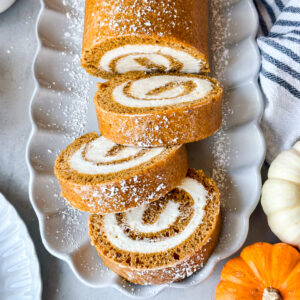
Sourdough Pumpkin Roll (long ferment option)
Pumpkin roll is such a classic dessert that so many love to see on their holiday tables, and I just knew I had to make a sourdough version of this iconic cake. Think soft, spiced pumpkin sponge cake with a silky cream cheese swirl that rolls up perfectly every time. This Sourdough Pumpkin Roll (long ferment option) combines the nostalgia of the classic dessert with the magic of sourdough giving you the choice to bake it same-day or let the batter rest overnight for a richer flavor, extra tenderness, and all of the benefits of fermentation.
Equipment
- 10×15-inch jelly roll pan - this pan size is the standard size for cake rolls and usually any standard baking sheet with an edge will work.
- Mixing bowls - for mixing cake batter and icing.
- Whisk - for combining ingredients.
- Spatula - for folding ingredients and spreading cake batter.
- Kitchen scale (optional) - for accurate measuring especially helpful with sourdough baking.
- Measuring cups and spoons - to measure smaller ingredients.
- Parchment paper - for lining pans for a clean release. Don't skip this.
- Lint-free kitchen towel - To roll the cake.
- Plastic wrap - to wrap roll and chill.
- Small sieve or duster - to dust towel and cake with powdered sugar.
Ingredients
Fermented Cake Base:
- ½ (120g) cup sourdough starter or discard (100% hydration)
- ½ (100g) cup granulated white sugar
- ⅓ (65g) cup brown sugar
- 1/2 (140g) cup pumpkin puree
- 2 (30g) Tbsp sour cream
- 1 tsp vanilla extract
- ¾ (110g) cup all-purpose flour
Next Day Additions:
- 3 large eggs room temperature
- ¾ tsp baking powder
- ¼ tsp baking soda
- ¼ tsp fine sea salt
- 1½ tsp ground cinnamon
- ¾ tsp ground ginger
- ½ tsp ground nutmeg
- ⅛ tsp ground cardamom
Cream Cheese Filling:
- 8 (226g) oz cream cheese softened
- 6 (85g) Tbsp unsalted butter softened
- 1½ (180g) cups powdered sugar
- 1 tsp vanilla extract
- 1/8 tsp sea salt
For Dusting:
- 2/3 (80g) cup powdered sugar
Instructions
Step 1: Prepare the Base for Overnight Fermentation
- To ferment this cake batter, you'll start by mixing in a bowl the sourdough starter, flour, white sugar, brown sugar, pumpkin, sour cream, and vanilla. Just give this a quick stir to incorporate the ingredients, then cover with plastic and transfer the bowl to the refrigerator overnight.½ (120g) cup sourdough starter or discard (100% hydration), ½ (100g) cup granulated white sugar, ⅓ (65g) cup brown sugar, 1/2 (140g) cup pumpkin puree, 2 (30g) Tbsp sour cream, 1 tsp vanilla extract, ¾ (110g) cup all-purpose flour
Same Day Bake Option: If you don't want to ferment this batter overnight and want to bake the same day, proceed to the next step without refrigeration or allowing batter to rest.
Step 2: Finish Combining the Batter
- If batter was refrigerated overnight, remove from the refrigerator and allow to rest at room temperature for about an hour to an hour and half so that the batter isn't cold. If batter wasn't refrigerated skip this step.
- Once batter has rested, add the eggs and mix on low with hand beaters or a whisk until the batter is smooth. DON"T OVERMIX.3 large eggs
- Sprinkle the baking powder, baking soda, cinnamon, ginger, nutmeg and cardamom into the batter and whisk or mix on low until no streaks remain. This should only take 30 seconds to a minute, you don't want to overbeat the batter or the cake will be tough.¾ tsp baking powder, ¼ tsp baking soda, ¼ tsp fine sea salt, 1½ tsp ground cinnamon, ¾ tsp ground ginger, ½ tsp ground nutmeg, ⅛ tsp ground cardamom
Step 3: Bake and Roll Cake
- Preheat oven to 350°F (177°C). Spray your cake pan lightly with cooking spay to help your parchment paper stick, then line with parchment paper and lightly mist again with cooking spray.
- Note: you want your parchment paper to have about a 1 inch lip on the long sides of your cake pan, with no lip at the top and bottom. This makes for a clean release from the pan.
- Pour the batter into the cake pan, make sure to get any last bits in the bowl. Spread the batter evenly over the pan to the edges, then tap the pan on the counter to release any air bubbles and even out the batter.
- Transfer your cake pan to your preheated oven and bake for 14-15 minutes on the center rack. Your cake is done when the top springs back when lightly touched and edges pull away slightly. Don't overbake this cake, or you'll end up with cracking when you roll it!
- While your cake is baking, lay a clean lint-free kitchen towel out on a clean work surface. You're going to use this towel to wrap your cake up into a log, helping it hold the roll shape we want. I don't recommend using parchment, because it doesn't allow the cake to sweat and cool properly for a perfect cake roll.
- Fold the towel if needed to be just an inch or two wider than your cake pan. Dust the top liberally with 1/3 cup powdered sugar about the size of your cake pan.2/3 (80g) cup powdered sugar
- As soon as your cake is done, remove from the oven and allow to rest 1 minute. Then, carefully flip the pan onto the kitchen towel that has been powdered with sugar as close to the bottom edge of the kitchen towel as possible. Carefully remove the parchment from the top of the cake.
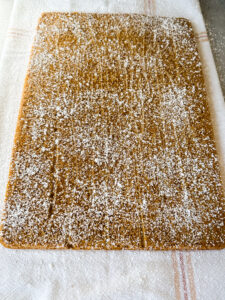
- Dust the top of the cake with another 1/3 cup powdered sugar.
- Working carefully but quickly, roll up the cake at the end with the towel until all of the cake has been rolled into a neat log into the towel.

- Allow this cake log to cool for at least 2 hours. This step will give the cake the memory of the roll, and the cooling process will avoid cracking.
Step 4: Fill the Roll
- After the roll has cooled for a few hours, prepare your cream cheese filling.
- In a bowl, add your softened cream cheese and softened butter.8 (226g) oz cream cheese, 6 (85g) Tbsp unsalted butter
- Beat cream cheese and butter on high with hand beaters or a stand mixer with a whisk attachment for about two minutes until pale and fluffy.
- Add the vanilla and salt to the filling, and mix in for a minute.1 tsp vanilla extract, 1/8 tsp sea salt
- Add powdered sugar to the filling, and combine on low until the sugar has been combined into the filling.1½ (180g) cups powdered sugar
- Then turn mixer to high and beat for another minute or two until the icing is light and fluffy.
- On a clean work surface, gently unroll your cake out of the towel.

- Transfer all of the cream cheese filling to the top of the cake, and spread the icing evenly over the top leaving a 1/2 inch border at the top of the cake as pictured below. Make sure the icing is spread under the edge that has curled under as this will be the center of the roll! We don't want that empty.
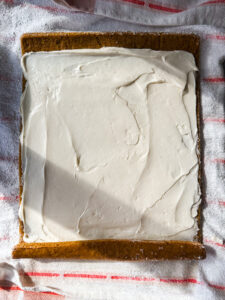
- Gently roll the cake back up (this time without the towel), until you've formed a log again. Place a piece of plastic wrap at the edge of the roll and gently roll the cake roll onto the plastic.
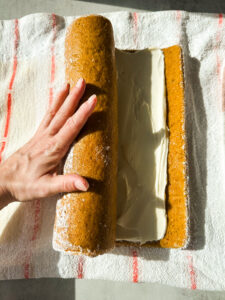
- Completely wrap the roll in plastic and seal, then place on a cookie sheet and transfer to the refrigerator to set up.
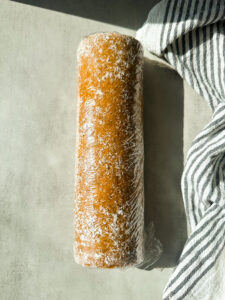
- Refrigerate the roll at least 2 hours or overnight to set up completely.
Step 5: Slice and Serve
- When you're ready to serve the cake roll, gently unwrap from the plastic and transfer to a serving platter.
- Lightly dust the cake roll with more powdered sugar, then wet a serrated knife and cut the roll into 8 clean sections. Serve and enjoy!
- Tip: Using a wet knife and cleaning between slices makes for the cleanest cuts so your roll doesn't smudge.
Notes
How to Store:
Refrigerator- Keep roll wrapped and chilled for up to 4 days. Slice and serve! Freezer- Wrap tightly in plastic and freeze for up to 1 month. Thaw in the refrigerator overnight before slicing and serving. Tried this recipe?Let us know how it was!